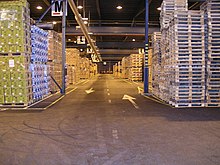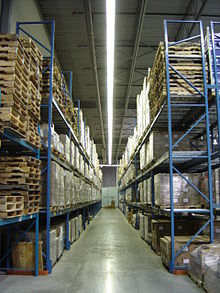Warehouse
This article needs additional citations for verification. (March 2009) |


A warehouse is a commercial building for storage of goods. Warehouses are used by manufacturers, importers, exporters, wholesalers, transport businesses, customs, etc. They are usually large plain buildings in industrial areas of cities and towns and villages. They usually have loading docks to load and unload goods from trucks. Sometimes warehouses are designed for the loading and unloading of goods directly from railways, airports, or seaports. They often have cranes and forklifts for moving goods, which are usually placed on ISO standard pallets loaded into pallet racks. Stored goods can include any raw materials, packing materials, spare parts, components, or finished goods associated with agriculture, manufacturing, or commerce.
Storage and shipping systems


Some of the most common warehouse storage systems are:
- Pallet racking including selective, drive-in, drive-thru, double-deep, pushback, and gravity flow
- Mezzanine including structural, roll formed, racks
- Vertical Lift Modules
- Horizontal Carousels
- Vertical Carousels
A piece pick, also known as broken case pick, split-case pick, each pick, over-pack or pick/pack, is a type of order selection process where product is picked and handled in individual units and placed in an outer carton, tote or other container before shipping. Catalog companies and internet retailers are examples of predominantly piece-pick operations. Their customers rarely order in pallet or case quantities; instead, they typically order just one or two pieces of one or two items.
Material direction and tracking in a warehouse can be coordinated by a Warehouse Management System (WMS), a database driven computer program. Logistics personnel use the WMS to improve warehouse efficiency by directing pathways and to maintain accurate inventory by recording warehouse transactions.
Automation and optimization

Some warehouses are completely automated, and require only operators to work and handle all the task. Pallets and product move on a system of automated conveyors, cranes and automated storage and retrieval systems coordinated by programmable logic controllers and computers running logistics automation software. These systems are often installed in refrigerated warehouses where temperatures are kept very cold to keep product from spoiling, especially in electronics warehouse where they require specific temperature to avoid damaging the parts, and also where land is expensive, as automated storage systems can use vertical space efficiently. These high-bay storage areas are often more than 10 meters (33 feet) high, with some over 20 meters (65 feet) high. Automated storage systems can be built up to 40m high.
For a warehouse to function efficiently, the facility must be properly slotted. Slotting addresses which storage medium a product is picked from (pallet rack or carton flow), and how they are picked (pick-to-light, pick-to-voice, or pick-to-paper). With a proper slotting plan, a warehouse can improve its inventory rotation requirements—such as first in, first out (FIFO) and last in, first out (LIFO)—control labor costs and increase productivity.[1]
Modern trends

Traditional warehousing has declined since the last decades of the 20th century, with the gradual introduction of Just In Time (JIT) techniques. The JIT system promotes product delivery directly from suppliers to consumer without the use of warehouses. However, with the gradual implementation of offshore outsourcing and offshoring in about the same time period, the distance between the manufacturer and the retailer (or the parts manufacturer and the industrial plant) grew considerably in many domains, necessitating at least one warehouse per country or per region in any typical supply chain for a given range of products.
Recent retailing trends have led to the development of warehouse-style retail stores. These high-ceiling buildings display retail goods on tall, heavy duty industrial racks rather than conventional retail shelving. Typically, items ready for sale are on the bottom of the racks, and crated or palletized inventory is in the upper rack. Essentially, the same building serves as both warehouse and retail store.
Another trend relates to Vendor Managed Inventory (VMI). This gives the vendor the control to maintain the level of stock in the store. This method has its own issue that the vendor gains access to the warehouse.
Large exporters/manufacturers use warehouses as distribution points for developing retail outlets in a particular region or country. This concept reduces end cost to the consumer and enhances the production sale ratio.
Cool warehouses and cold storage
Cold storages preserve agricultural products at low temperature. Refrigerated storage helps in eliminating sprouting, rottage and tuber moth damage and in reducing weight loss of the agricultural produce. The edible products are generally not stored for more than one year. Several cold storage store perishable products which require the storage temperature as low as -25°C.
Cold storage helps stabilize market prices and evenly distribute goods both on demand basis and time basis. The farmers get opportunity of producing cash crops to get remunerative prices. The consumers get the supply of perishable commodities with lower fluctuation of prices.
Ammonia and Freon compressors are commonly used in cold storage warehouses to maintain the temperature. Ammonia refrigerant is cheaper, easily available and has a high latent heat of evaporation but it is also highly toxic and can form an explosive mixture when mixed with oil containing high percentage of carbon. Insulation is also important, to reduce loss of cold and to keep different sections of the warehouse at different temperatures.
There are two main types of refrigeration system used in cold storage warehouses, a Vapour absorption system (VAS) and Vapour compression system (VCS). VAS, although comparatively costlier, is quite economical in operation and adequately compensates the higher initial investment.
The temperature necessary for preservation depends on the storage time required and the type of product. In general, there are three groups of products, foods that are alive (e.g. fruits and vegetables), foods that are no longer alive and have been processed in some form (e.g. meat and fish products), and commodities that benefit from storage at controlled temperature (e.g. beer, tobacco).
Location is a very critical aspect for the success of cold storage. It should be in close proximity of growing area as well as market, be easily accessible for heavy vehicles, and have uninterrupted power supply.
Cold storage and the law
There are state and local laws which regulate the cold store industry, requiring safe working conditions for employees, and operational procedures must be in accordance with these laws. Those companies which do their homework and prepare in advance for inspections and other routine enforcement protocols will be able to continue operating at full capacity, ensuring greater customer service and more product flow seven days a week.
Internet impact

Internet-based stores do not require physical retail space, but still require warehouses to store goods. This kind of warehouse fills many small orders directly from end customers rather than fewer orders of many items from stores.
Having a large and complex supply chain containing many warehouse can be costly. It may be beneficial for a company to have one large warehouse per continent, typically located centrally to transportation. At these continental hubs, goods may be customized for different countries. For example, goods get a price ticket in the language of the destination country. Small, in-warehouse adjustments to goods are called value added services.
See also
- Automated storage and retrieval system
- Document automation in supply chain management & logistics
- Data warehouse
- Inventory
- Inventory management software
- Kiva Systems—a manufacturer of robots for warehouse automation
- Pick and pack
- RFID
- Shipping list
- Shipwire—pioneer in outsourced warehousing and order fulfillment
- Voice Directed Warehousing
- Warehouse management system
- WERC, Warehousing Education and Research Council
References
- ^ Effectively Slotting a Warehouse or Distribution Center by By Paul Hansen and Kelvin Gibson. Cygnus Supply and Demand Chain Executive. Accessed 2010-08-06.
Further reading
- The Story of the Bale. Manchester: Lloyd's Packing Warehouses Ltd, Princess Street, 1926
